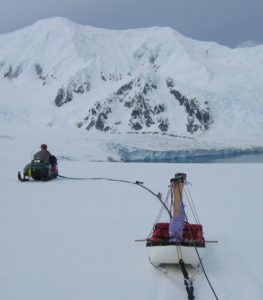Understanding the dynamic response of glaciers to climate changes
The final aim of this project is the prediction of the dynamic response of glaciers to climate changes, with an emphasis on tidewater glaciers. The main tool will be the numerical modelling of glacier thermo-mechanics, with focus on calving processes, using boundary conditions supplied by glaciological field data. The importance of this research subject has been stressed by the recent IPCC AR4, that has pointed out that 'Dynamical processes related to ice flow not included in current models but suggested by recent observations could increase the vulnerability of the ice sheets to warming, increasing future sea level rise'. In spite of its important contribution to the mass budget of tidewater glaciers and ice sheets, iceberg calving is yet poorly constrained; a key question that we aim to answer is whether stable calving front positions are possible on reverse-bed slopes, as suggested by recent numerical modelling experiments by Nick et al (2010).
In order to get a proper initialization of the models of glacier dynamics, consistent with observations of the present geometry and velocities, we plan to implement in our model data assimilation techniques such as those suggested by Anthern and Gudmundsson (2010), that can be viewed as an inverse procedure to solve for ice viscosity and basal drag coefficient. Of particular interest to us will be to analyze whether a friction law involving cavitation, such as that suggested by Gagliardini et al (2007), provides a more adequate representation of basal sliding than the classical Weertman-type law. Inclinometry measurements in boreholes drilled to the bed are ideal to constrain the basal sliding, because they allow to separate the two main components of glacier velocity (internal deformation and basal slip); we plan to perform such measurements on Johnsons-Hurd glaciers. Furthermore, pressure gauges placed at the base of the boreholes provide information on basal water pressure, that plays a crucial role in glacier sliding.
The dynamic response of a glacier depends strongly on its hydrothermal structure; this is because, in cold ice, the viscosity is highly dependent on temperature, while in temperate ice it strongly depends on the liquid water content. Understanding the hydrothermal structure is therefore essential to a proper representation of glacier dynamics.
Ground-penetrating radar (GPR) constitutes the most efficient tool for determining the hydrothermal structure of glaciers, so we plan to undertake GPR measurements on both Livingston Island and Svalbard glaciers. The radar techniques considered include the estimate of power reflection coefficients from GPR profiles (to get information on the hydrological conditions within the glacier body and at the ice-bed interface), and the calculation, from common midpoint measurements, of the radio-wave velocity in ice, that allows to estimate the water content in temperate ice. Borehole thermometry can provide fully conclusive evidence of the thermal structure, so our boreholes will also be of great help for this purpose.
We also plan to continue the monitoring of the surface mass balance (SMB) of Johnsons and Hurd glaciers, and continue providing these data to the UNESCO-sponsored World Glacier Monitoring Service data base. SMB, together with calving flux estimates, can be compared with geodetic mass balance estimates to resolve for the large uncertainties inherent to the computation of the mass budget of glaciers.
REFERENCES:
Arthern, RJ and GH Gudmundsson, 2010, Initialization of ice-sheet forecasts viewed as an inverse Robin problem, J Glaciol, 56(197), 527-533.
Gagliardini, O, D Cohen, P Råback and T Zwinger, 2007, Finite-element modeling of subglacial cavities and related friction law, J Geophys Res, 112(F02027), doi:101029/2006JF000576.
Nick, FM and others, 2010, A physically based calving model applied to marine outlet glaciers and implications for the glacier dynamics, J Glaciol, 56(199), 781-794.
